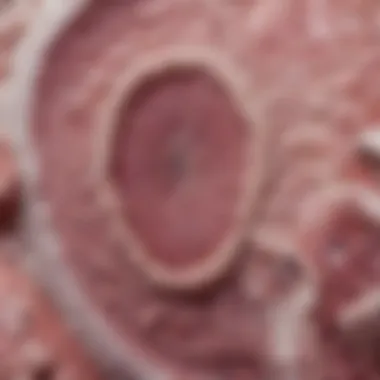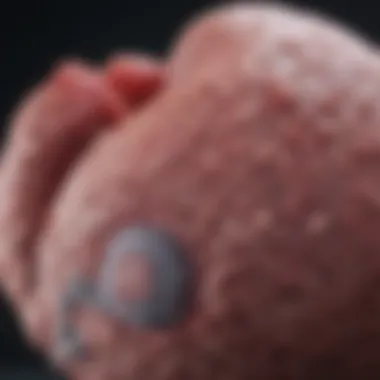Understanding Pleomorphic Lobular Carcinoma in Situ


Intro
Pleomorphic lobular carcinoma in situ (PLCIS) presents a complex challenge in breast pathology. Recent studies have highlighted its distinct histological characteristics. As this understanding evolves, clarity around its clinical implications is crucial. More so, the significance of effective communication between healthcare providers and patients cannot be overstated. This article aims to provide a comprehensive overview of PLCIS, focusing on various dimensions including genetic factors, management strategies, and its differentiation from other breast lesions.
Research Overview
In recent years, research into PLCIS has gained momentum. The exploration of its unique histopathological features has paved the way for improved diagnostic criteria and treatment protocols.
Methodological Approaches
Studies employ various methodological approaches to investigate PLCIS. These often include:
- Histopathological analysis: Examining tissue samples under microscopes to identify unique cellular patterns.
- Genetic profiling: Investigating mutations associated with PLCIS to understand its development better.
- Clinical data analysis: Evaluating patient outcomes and treatment effectiveness over time.
Significance and Implications
The significance of understanding PLCIS extends beyond academic interest. It impacts clinical practices in several ways:
- Early diagnosis can lead to timely treatment interventions.
- Recognizing PLCIS can inform prognosis and follow-up strategies.
- Clinical awareness can enhance patient education, providing individuals with critical insights into their health.
Recent evidence suggests that patients with PLCIS may have a higher risk of invasive breast cancer, underscoring the need for vigilant monitoring.
Current Trends in Science
The realm of breast pathology, particularly concerning PLCIS, is rapidly evolving. Taking notice of current trends can provide fresh insights into effective management and research advances.
Innovative Techniques and Tools
Emerging technologies have begun to play significant roles in the investigation and management of PLCIS. Key innovations include:
- Digital pathology: Utilizing advanced imaging techniques to enhance diagnostic accuracy.
- Molecular diagnostics: Implementing genetic tests to determine individual risks and tailor treatments.
Interdisciplinary Connections
Understanding PLCIS is not confined strictly to pathology. Interdisciplinary collaborations are increasingly common. Fields such as genetics, oncology, and radiology are working together to advance knowledge and treatment approaches. This convergence allows for:
- Holistic view on patient care, considering genetic predisposition, age, and overall health.
- Improved patient outcomes through comprehensive treatment strategies and follow-ups.
In summary, the understanding of PLCIS is critical for professionals in the medical field. As research progresses, the integration of knowledge from diverse disciplines will be vital in creating effective management strategies and improving patient care.
Intro to Pleomorphic Lobular Carcinoma in Situ
Pleomorphic lobular carcinoma in situ, often abbreviated as PLCIS, presents a complex area within breast pathology. Understanding this entity is crucial for both medical professionals and individuals affected by this condition. The significance of PLCIS lies in its unique histological features and its potential implications for breast cancer risk. Through this article, we aim to provide a comprehensive overview that elucidates its characteristics, historical background, and clinical relevance.
Definition and Overview
Pleomorphic lobular carcinoma in situ is defined as a variant of lobular carcinoma in situ characterized by certain histological features. Specifically, it displays a heterogeneous population of cells that exhibit variation in size and shape, which distinguishes it from conventional lobular carcinoma in situ. This increasing diversity of cellular morphology suggests a potential for a more aggressive clinical behavior. PLCIS is observed during histological examinations of breast tissue, often discovered incidentally during biopsies intended for other conditions.
Understanding the distinct features of PLCIS is crucial because it alters the approach to patient management and risk stratification. Given that patients with PLCIS may have a higher risk for developing invasive breast cancer, clear guidelines for surveillance and treatment are essential. Thus, grasping the definition and overview of PLCIS is a foundational step in its effective management.
Historical Context
The recognition of pleomorphic lobular carcinoma in situ is relatively recent in the history of breast pathology. While lobular carcinoma in situ has been documented for many years, PLCIS emerged as a separate entity within the last two decades. Early studies began to highlight the variations in cellular characteristics that are inconsistent with conventional forms of lobular carcinoma in situ. The contributions from pathologists and researchers led to an evolving understanding of this condition, culminating in its classification as an important variant with distinct implications.
Clinically, the identification of PLCIS has prompted changes in screening practices and recommendations for follow-up care in at-risk populations. As the body of literature grows, ongoing research will continue to clarify the role of PLCIS in breast cancer etiology. Overall, the historical context sets the stage for further exploration of both the molecular underpinnings and treatment approaches unique to this type of cancer.
Histological Features
Microscopic Characteristics
Microscopic analysis reveals distinctive features of PLCIS. Under the microscope, the lobular architecture is disrupted. The tumor cells exhibit pleomorphism, characterized by variations in size and shape. Nuclear atypia is also pronounced, with irregular nuclear contours and prominent nucleoli. These cells may present in isolated clusters or single-file patterns, which is an important aspect for identification.


In addition, the background stroma often appears desmoplastic, indicating a response to the tumor's presence. The combination of these microscopic characteristics contrasts PLCIS with typical lobular carcinoma, enhancing diagnostic accuracy.
Differential Diagnosis
Making a correct diagnosis of PLCIS involves careful consideration of various conditions that share overlapping features. Key differential diagnoses include typical lobular carcinoma in situ, invasive lobular carcinoma, and other types of breast lesions.
It is important to differentiate PLCIS from these entities due to differences in management and prognosis. For instance, while typical lobular carcinoma in situ tends to have a more indolent course, PLCIS may present a greater risk for progression to invasive disease. Utilizing a combination of histological evaluation and immunohistochemical staining is crucial in establishing the correct diagnosis and informing the clinical approach.
Immunohistochemical Markers
Immunohistochemical markers play an essential role in the diagnosis and characterization of PLCIS. These markers help to clarify the tumor's biological behavior and can also assist in distinguishing it from other breast lesions. Commonly studied markers include E-cadherin, which is often lost in lobular carcinoma, including PLCIS. In contrast, markers such as estrogen receptor (ER) and progesterone receptor (PR) status can provide information regarding the hormonal influences on the tumor.
The application of immunohistochemical staining techniques is fundamental in enhancing the accuracy of PLCIS diagnosis, enabling clinicians to devise effective management strategies.
In summary, the histological features, including microscopic characteristics, differential diagnosis, and immunohistochemical markers, contribute to a deeper understanding of pleomorphic lobular carcinoma in situ. This knowledge serves as a crucial foundation for clinicians and researchers alike as they work towards improving patient outcomes.
Epidemiology
Epidemiology plays a critical role in comprehending pleomorphic lobular carcinoma in situ (PLCIS). It offers insights into the frequency and distribution of this specific breast lesion. Understanding incidence and prevalence aids healthcare professionals in framing effective screening protocols. Early identification of PLCIS can lead to more informed management decisions and ultimately improve patient outcomes.
Incidence and Prevalence
The incidence of PLCIS has become a focal point in breast pathology research. Current evidence indicates that PLCIS, while a rare form, occurs with increasing frequency. Recent studies show that about 3–10% of all lobular carcinoma cases are pleomorphic in nature. This variability highlights its atypical presence among breast lesions. Most occurrences are found in postmenopausal women, making age a relevant statistic in studies examining prevalence.
Prevalence rates also vary based on geographical and ethnic demographics. Some regions report higher rates, possibly related to differences in screening practices or genetic factors. Understanding these changes is vital for tailoring public health initiatives geared toward early detection and education.
Risk Factors Associated with PLCIS
Risk factors for PLCIS can be multi-faceted, often overlapping with those for other breast carcinomas. Recognizing these risk factors is essential for developing preventative strategies. Some of the known risk factors include:
- Age: As noted, PLCIS primarily affects older women, particularly those aged 50 years and above.
- Family History: A family history of breast cancer can increase the likelihood of developing PLCIS.
- Hormonal Factors: Hormonal changes and influenced conditions, such as obesity and the use of hormone replacement therapy, have been associated with the development of PLCIS.
- Genetic Mutations: Mutations in BRCA1 and BRCA2 increase breast cancer risk and may correlate with PLCIS incidence.
"Understanding the epidemiology of pleomorphic lobular carcinoma in situ is essential for effective screening and targeted treatments."
By analyzing these risk factors comprehensively, healthcare providers can focus on individual patient history, enabling them to create preventive care strategies. Research in this field is ongoing, revealing more complex interactions that contribute to PLCIS development. This will lead to better patient management and more effective communication strategies in clinical settings.
Genetic and Molecular Insights
Genetic and molecular insights into pleomorphic lobular carcinoma in situ (PLCIS) provide an essential foundation for understanding this breast pathology. The genetic profile of PLCIS reveals significant alterations that can aid in proper diagnosis and treatment planning. Analyzing these genetic changes not only enhances comprehension of the condition but also helps predict patient outcomes, thereby providing vital information for both clinicians and patients. Furthermore, hormonal influences on PLCIS are a critical area of study. They elucidate how hormonal environments may affect the progression of this carcinoma in situ, leading to better-established management strategies.
Genetic Alterations in PLCIS
Genetic changes play a crucial role in the development of PLCIS. Research indicates that specific genetic alterations, such as mutations in the PIK3CA and TP53 genes, are commonly observed in this subtype of breast cancer. These mutations can influence tumor behavior and responsiveness to therapy.
- Key Genetic Alterations:
- PIK3CA Mutations: Frequently found in many breast cancers, these mutations signal enhancements in cell growth and survival.
- TP53 Mutations: Often associated with various cancer types, TP53 mutations indicate disrupted normal apoptotic pathways, potentially contributing to tumor progression.
Identification of these mutations is essential. It guides targeted therapies. For instance, if a tumor shows a PIK3CA mutation, it may respond better to PIK3CA inhibitors like alpelisib.
Genetic profiling of PLCIS can identify patients at risk for invasive cancer. This profiling aids in managing the disease more effectively. Understanding these genetic alterations also opens avenues for research into new treatment modalities tailored to an individual’s genetic makeup.
Role of Hormonal Influences
Hormonal influences significantly impact the pathology of PLCIS. The role of estrogen can not be overstated, as it is known to fuel the growth of hormone-sensitive breast cancers.
- Factors of Hormonal Influence:
- Estrogen Receptor Activation: Estrogen receptor-positive PLCIS is known to exhibit growth in response to estrogen, often complicating treatment decisions.
- Hormonal Therapies: Treatment for PLCIS might include anti-estrogen therapies such as tamoxifen or aromatase inhibitors. These therapies can help reduce the risk of recurrence.
The interplay between PLCIS and hormones might also be a factor in how this condition progresses to invasive cancer. Understanding these hormonal influences can lead to improved patient outcomes. As studies continue to explore the hormonal environment surrounding PLCIS, more refined treatment strategies may emerge, fostering hope for future therapies.
Remaining aware of the genetic and hormonal influences on PLCIS is essential for implementing effective management strategies.


Clinical Presentation
The clinical presentation of pleomorphic lobular carcinoma in situ (PLCIS) plays a key role in identifying and managing this specific type of breast pathology. It is crucial for healthcare providers to recognize the symptoms and follow appropriate diagnostic protocols. Understanding the clinical signs helps in early detection, which is essential since this condition can lead to an increased risk of developing invasive lobular carcinoma.
Typical Symptoms and Signs
Patients with PLCIS often do not present specific symptoms at the early stages. This can make diagnosis challenging. However, some general signs related to breast conditions may be observed, including:
- Breast Lump: Patients might notice a palpable lump in the breast tissue.
- Changes in Breast Shape or Size: Any noticeable alterations should be documented.
- Nipple Discharge: Although not common, any unusual discharge from the nipple may raise concerns.
- Skin Changes: This can include pitting or dimpling of the breast skin.
- Localization of Pain: Some patients report localized pain or discomfort in the breast area.
Awareness of these atypical presentations is vital for both patients and healthcare workers. Early assessment can provide critical information that guides further analysis and monitoring.
Diagnosis Protocols
The diagnostic protocols for PLCIS are essential for confirming the presence of this condition and reassuring the patient. Typically, the diagnosis involves a combination of imaging and biopsies:
- Mammography: Often the first step, this imaging test helps identify abnormalities in breast tissue.
- Ultrasound: After initial findings, ultrasound may be used to provide a clearer image. This helps differentiate between solid masses and cysts.
- Biopsy: If abnormalities are noted, a core needle biopsy or excisional biopsy is performed to obtain tissue samples for histological examination.
Histopathological analysis remains the gold standard in confirming PLCIS. Specific markers identified during this process include distinctive features of the lobular architecture. Additionally, immunohistochemistry plays a role in confirming the diagnosis by examining the expression of markers.
"In clinical practice, timely diagnosis is pivotal, enabling better patient outcomes and guiding management decisions effectively."
Establishing a precise diagnosis allows healthcare professionals to discuss appropriate management options with the patient. This ongoing dialogue is crucial for tailored patient care.
Management Strategies
Management strategies for pleomorphic lobular carcinoma in situ (PLCIS) are crucial for delineating appropriate patient care and outcomes. The unique features of PLCIS necessitate tailored approaches to therapy. The primary focus lies in effectively addressing the risk of progression to invasive breast cancer while considering the patient’s individual circumstances.
Surgical Approaches
Surgical intervention remains a cornerstone in managing PLCIS. Typically, a lumpectomy or mastectomy may be recommended based on the extent of the disease, patient preferences, and overall clinical context.
The main objectives of surgical approaches include:
- Removal of affected tissue: This is vital for both diagnostic and therapeutic purposes.
- Reduction of recurrence risk: Surgical excision decreases the likelihood of the disease advancing to an invasive stage.
- Pathological assessment: Surgical specimens provide essential information on the tumor’s characteristics, aiding in further treatment planning.
Despite its benefits, surgery is not without considerations. Patients must be informed about:
- Potential complications, such as infection or scarring.
- Emotional impacts, as the loss of breast tissue can lead to psychological distress.
Close collaboration between surgical oncologists, pathologists, and radiologists is essential to ensuring optimal results. Each decision should be guided by comprehensive preoperative evaluations and discussions regarding the patient's health goals.
Nonsurgical Interventions
Nonsurgical management of PLCIS includes a range of treatments aimed at monitoring and reducing the risk of disease progression. These strategies can be essential for patients who may prefer avoiding surgery or are not candidates due to other health issues.
Common nonsurgical interventions include:
- Regular surveillance and imaging: Techniques such as mammography and MRI help in early detection of any changes in the condition.
- Hormonal therapies: Estrogen-receptor antagonists like Tamoxifen or aromatase inhibitors may be employed to lower the risk of developing invasive cancer.
- Lifestyle modifications: Educating patients on diet, exercise, and weight management plays a significant role in overall health and may impact cancer outcomes.
With nonsurgical approaches, the need for patient education cannot be overstated. Informed patients are more likely to engage in their care and adhere to prescribed management plans. Regular follow-ups are vital to assess the effectiveness of these interventions and adjust them as necessary.
Prognosis and Outcomes
Understanding the prognosis and outcomes for patients diagnosed with pleomorphic lobular carcinoma in situ (PLCIS) is vital. Prognosis relates to the likely course of the disease and the chances of recovery. Outcomes can include survival rates and the likelihood of recurrence. Both aspects inform patients and healthcare providers about possible future developments and treatment paths.
The prognosis for PLCIS can differ from other breast lesions. In general, the presence of PLCIS may indicate a higher risk of subsequent invasive breast cancers. Therefore, monitoring and management strategies play a crucial role in improving patient outcomes. It is essential for both patients and physicians to be well-informed about what this diagnosis may entail.
Long-Term Survival Rates
Long-term survival rates provide essential information for patients diagnosed with PLCIS. Recent studies indicate that the prognosis is generally favorable in the absence of invasive disease. According to data, the five-year survival rates for patients with non-invasive breast cancer, like PLCIS, are comparable to those found in other in situ lesions.


- Key Statistics:
- The overall survival rate for individuals with PLCIS initially diagnosed and appropriately managed often exceeds 90%.
- Data suggests that upon appropriate intervention, the majority of patients remain free from disease over the long term.
However, ongoing surveillance is necessary. Patients are advised to engage in regular mammograms and clinical assessments. These follow-ups could identify potential invasive developments early, thus contributing positively to long-term outcomes.
Recurrence Patterns
Recurrence is a significant concern for any cancer diagnosis, and understanding the patterns for PLCIS is important for patient management. Recurrence can occur in two primary ways: local recurrence at the original site or progression to invasive cancer. Studies reveal that while the risk of local recurrence is present, it tends to be lower with effective management strategies.
- Factors Influencing Recurrence:
- The initial diagnosis of PLCIS
- Histological characteristics of the tumor
- Patient adherence to recommended follow-up protocols
Research shows that about 10-20% of patients with PLCIS may experience recurrence over a 10-year period. Ongoing research aims to clarify the molecular underpinnings associated with recurrence, which may lead to improved preventative measures in the future.
"Knowledge of prognosis and potential recurrence helps healthcare providers guide patients in making informed decisions about their treatment options."
Emerging Research
Emerging research into pleomorphic lobular carcinoma in situ (PLCIS) holds significant implications for understanding breast pathology and improving patient management. This area of study is essential as it can lead to the identification of new biomarkers, better diagnostic tools, and innovative treatment methodologies. The exploration of PLCIS also reflects advancements in breast cancer genetics and its impact on patient outcomes.
Research in this field offers a multifaceted view of PLCIS that encompasses not only its biological behavior but also its interaction with existing breast cancer types. As researchers delve deeper into the unique characteristics of PLCIS, they can better elucidate the relationship between this condition and the overall risk of developing invasive breast cancer. This exploration is crucial for tailoring patient management strategies.
Key elements of emerging research on PLCIS include:
- Genomic studies that seek to determine genetic alterations specific to PLCIS, which may inform future targeted therapies.
- Longitudinal studies that track the progression of this condition over time, providing insights into recurrence and long-term survival rates.
- Clinical trials aimed at evaluating the efficacy of new treatment options for PLCIS, which can significantly alter the management landscape.
Moreover, the continuous evolution of imaging techniques offers potential benefits for earlier and more accurate diagnosis of PLCIS, potentially leading to improved prognostic outcomes for patients.
Patient Perspectives
Understanding patient perspectives is crucial in the exploration of pleomorphic lobular carcinoma in situ (PLCIS). This section highlights how patients view their diagnosis, treatment options, and the support systems available to them. The insights gathered from patient experiences significantly inform clinical practices and enhance the overall healthcare delivery process.
Understanding PLCIS
Patients diagnosed with PLCIS may find the terminology and implications intimidating. Therefore, it is important to present this information clearly. PLCIS is often described as a non-invasive type of breast cancer. It has unique histological features and carries different risk factors for progression compared to other types of breast carcinoma. Having an accurate understanding of PLCIS can empower patients to engage in informed discussions with their healthcare providers. Moreover, education about the disease can alleviate some anxiety associated with the diagnosis.
To facilitate understanding, healthcare professionals can utilize layman's terms when explaining the condition. Including visual aids such as diagrams of breast tissue may also enhance comprehension.
Counseling and Support
Counseling plays a pivotal role following a PLCIS diagnosis. The emotional and psychological impact on patients can be significant. Healthcare providers must not only focus on treatment but also on offering emotional support. Counseling can help patients process their feelings about the diagnosis, treatment options, and potential lifestyle changes.
Support groups can offer a community for those diagnosed with PLCIS. These groups foster a sense of belonging and provide platforms to share experiences. They can offer patients practical advice and emotional validation.
Health professionals should integrate psychological support services into their management strategies. This approach ensures patients do not feel isolated in their journey. Counseling combined with medical treatment can lead to better patient outcomes.
"The way health systems communicate about diagnoses can greatly influence patient coping mechanisms."
In summary, understanding PLCIS from a patient’s perspective is vital. It leads to improved communication, tailored support services, and better overall management of the condition.
Finale
In the landscape of breast pathology, pleomorphic lobular carcinoma in situ (PLCIS) represents a nuanced yet significant entity. For healthcare professionals, comprehending the intricacies of PLCIS is vital because it influences both diagnosis and treatment. The clinical presentation of PLCIS and its unique histological features indicate its distinction from other breast lesions, which in turn, shapes management strategies. Furthermore, understanding the genetic alterations that underpin PLCIS adds layers to its clinical implications. This knowledge is essential not only for pathology professionals but also for surgeons, oncologists, and primary care providers.
Summary of Findings
The article elucidates the following key points regarding PLCIS:
- Definition and Characteristics: This type of carcinoma exhibits unique histological markers that alert pathologists to its presence. Understanding these markers is crucial for proper diagnosis.
- Epidemiology: The incidence and associated risk factors provide context for healthcare providers, enabling better patient counseling and targeted screening efforts.
- Management: Various surgical and nonsurgical approaches have been outlined, offering a framework for effective treatment decisions.
- Prognosis: Patterns of recurrence and long-term survival rates inform patients about their outlook and help in creating personalized management plans.
- Emerging Research: Continuous studies underscore the importance of staying current with new findings to improve diagnostic accuracy and treatment.
Call for Continued Research
As the understanding of PLCIS evolves, the call for a robust research agenda becomes ever more compelling. Research must focus on:
- Molecular Pathways: Investigating the genetic and molecular basis of PLCIS could unlock new treatment strategies.
- Longitudinal Studies: Understanding how PLCIS impacts patients over time will enhance prognostic models.
- Interventional Trials: More studies are needed to compare the effectiveness of various management strategies.
- Patient-Centered Research: Engaging with patients about their experiences with PLCIS can yield valuable insights, leading to more tailored care.
Continued exploration into PLCIS has significant implications for advancing breast cancer awareness and improving patient outcomes.



